The area around Lake Mývatn in northern Iceland is home to several geological wonders, making it a standout stop along the Ring Road. Here are the very best things to do near Mývatn.
By: Paul Healy | Last Updated: | Jump to Comments
Mývatn is a rare wetland in northern Iceland where water and lava come together in remarkable ways.
You can walk across still-warm lava fields, hike through surreal volcanic formations, and explore fissures in the earth’s crust.
One of Iceland’s best natural hot springs is located near Mývatn, and there’s an extraordinary geothermal area filled with bubbling mud pots and steaming vents.
Despite all this, it’s often not on many visitors’ radar, and you might find some of these sites empty.
We’ve visited Mývatn three times on different trips to Iceland, and it remains one of the most interesting places to explore in the country.
Here’s a guide to the top things to do in the Mývatn area.
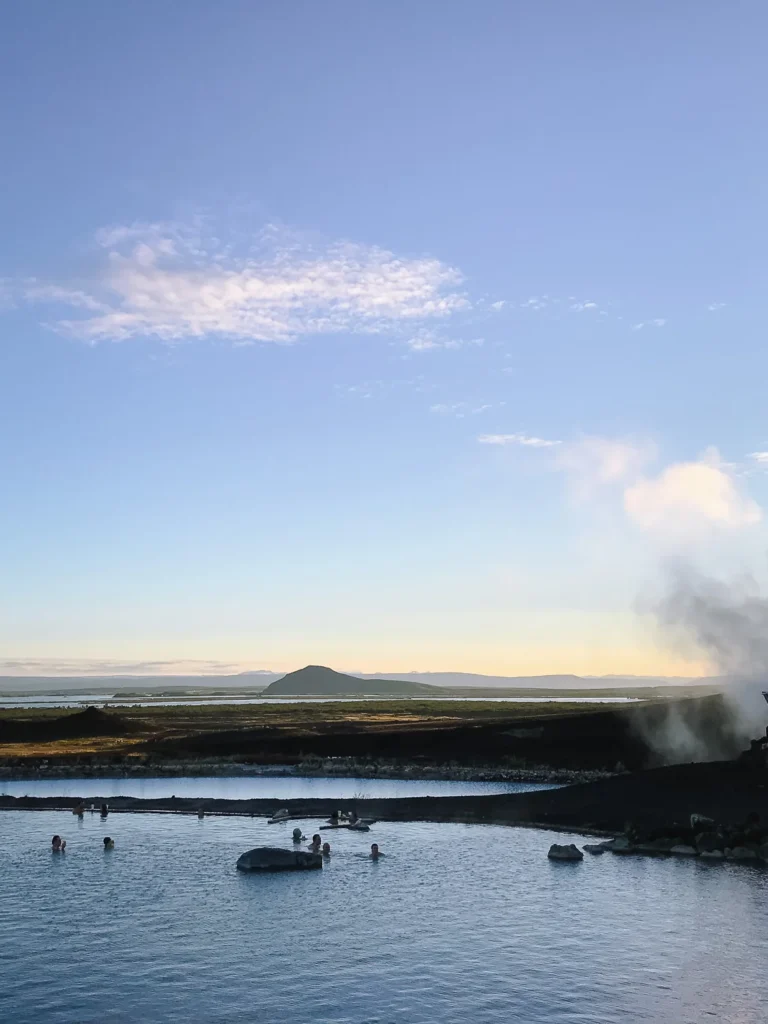

GET YOUR BEARINGS
There’s no town as such, but Mývatn covers a broad area of natural attractions surrounding the lake with a few services such as gas stations, some independent restaurants and several hotels dotted around.
As this part of north central Iceland is quite remote, Mývatn is a good base for day trips to explore the wider area.
We included Mývatn as a stop on our Ring Road itinerary.
USING OUR MAPS. Click on the top right corner to open in the Google Maps app. Click on the star to save to your Google account.
THINGS TO DO NEAR MYVATN, ICELAND
1. SKÚTUSTADAGÍGAR PSEUDO CRATERS
Pseudo craters are strange-looking natural formations resembling giant pimples in the Earth’s crust.
They are formed when hot lava flows over a wetland and boils the water. The steam produced by this process caused explosions, forming clusters of pseudo-craters.
The pseudo-craters at Lake Mývatn were formed 2,300 years ago and are among the largest in the world.
The best way to see the pseudo-craters is to take the lovely path around the Skútustadagígar Pond.
There are 2-kilometre and 3-kilometre trails around the lake, both very good for bird spotting.
This is a popular spot for bus groups, and it was pretty busy on our last visit—something relatively unusual in Mŷvatn. Our tip would be to go a bit later in the day, as most tour groups arrive in the morning.
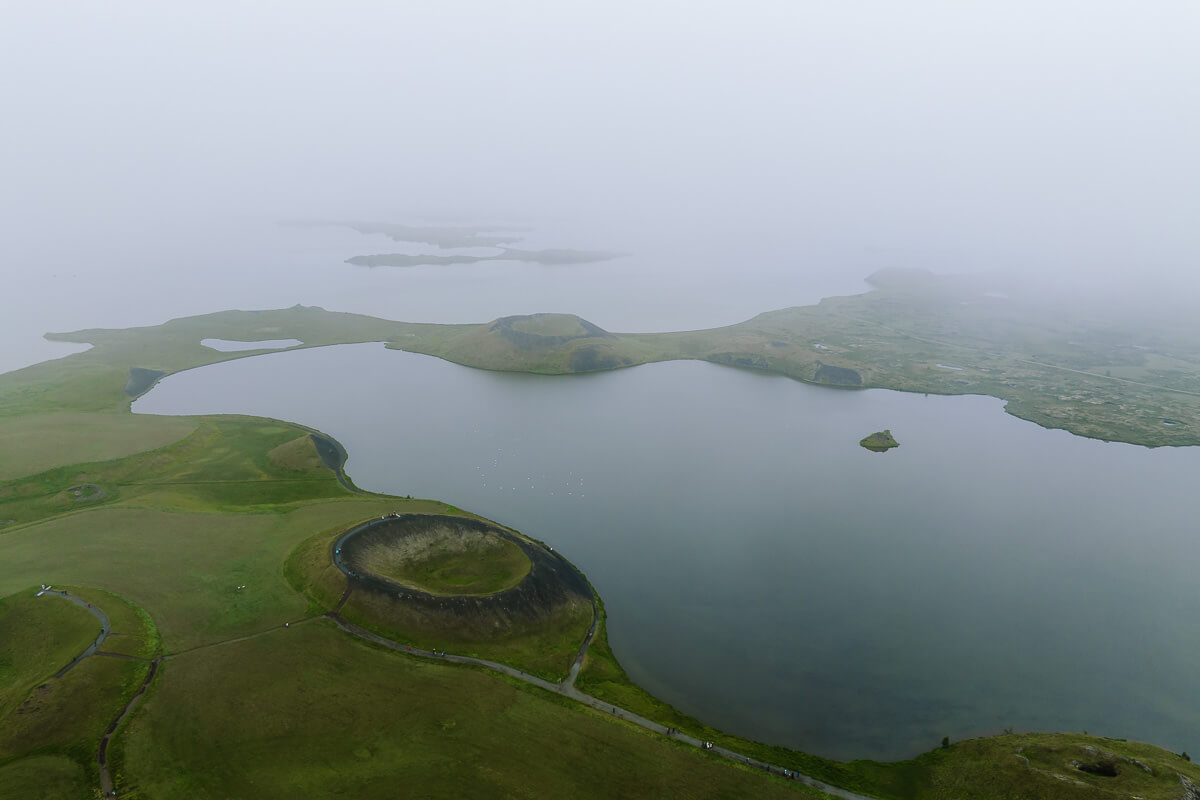

2. KÁLFASTRÖND
Kálfaströnd is a scenic area on the southeastern shore of Lake Mývatn, known for its unique lava formations, lush vegetation, and stunning views of the lake.
There is a 2.1-kilometre circuit that should only take around 35 minutes to explore. It’s very easy to follow and includes several secluded spots for a scenic picnic among the strange-shaped lava pillars.
The intriguing and varied landscape on the hike is prime habitat for Harlequin, Barrow’s Goldeneye, Golden Plover and plenty of ducks. So, if you’re a bird-watcher, you’ll be in your element.

3. DIMMUBORGIR
Dimmuborgir is a perfect example of the bizarre landscapes that surround the Mývatn area.
This lava field, dotted with towering pillars, jagged rock formations, and natural arches, was shaped by rare geological processes, giving it an eerie, almost mythical appearance.
The area was formed around 2,300 years ago when a massive lava lake—spanning approximately 2 kilometres—began to cool and drain into what is now Lake Mývatn.
What makes Dimmuborgir particularly unique is that these types of formations are typically found on the ocean floor, making Mývatn the only place in the world where you can see them on dry land.
Parking was 1,000 ISK on our last trip. However, it’s free if you make a purchase at the on-site cafe. The centre is open from 8 am to 7 pm daily.


4. HVERFJALL CRATER
Hverfjall is a tephra cone volcano near Mývatn, shaped like a massive stadium.
The volcano was formed around 4,500 years ago during a powerful explosive eruption, ejecting volcanic ash and rock to create its near-perfectly symmetrical cone.
The crater measures approximately 1 kilometer in diameter and rises 396 meters high, making it one of the largest tephra craters in the world.
There are two paths up to the rim of the crater, which provide excellent views of both the volcano’s centre and the surrounding area.
- Northwest Trail – The most commonly used and shortest route.
- Southern Trail – Less frequented, but provides an alternative ascent.
Both trails require a 20-minute uphill hike, with loose gravel making the terrain a bit challenging in places.
Once at the top, you can walk around the entire crater rim, which is around 3 kilometers (1.9 miles). This took us around 45–60 minutes.


5. GRJÓTAGJÁ CAVE & FISSURE
Grjótagjá is a small lava cave that shot to prominence after the love scene between Jon Snow and Ygritte from Game of Thrones was filmed there.
The cave contains a thermal pool, which for years was considered one of the prime hot springs in Iceland.
However, after the nearby Krafla volcanic system erupted nine times between 1975 and 1984, the water in the cave boiled to dangerous temperatures. The water eventually cooled, but the temperature has since become unstable, and swimming is no longer permitted.
Nonetheless, Grjótagjá is still a very interesting place to visit around Mývatn.
You can enter the cave via a small opening where you can see the clear, blue geothermal water.
Don’t miss the huge fissure, best seen from above the cave, which you can see stretching towards Hverfjall.
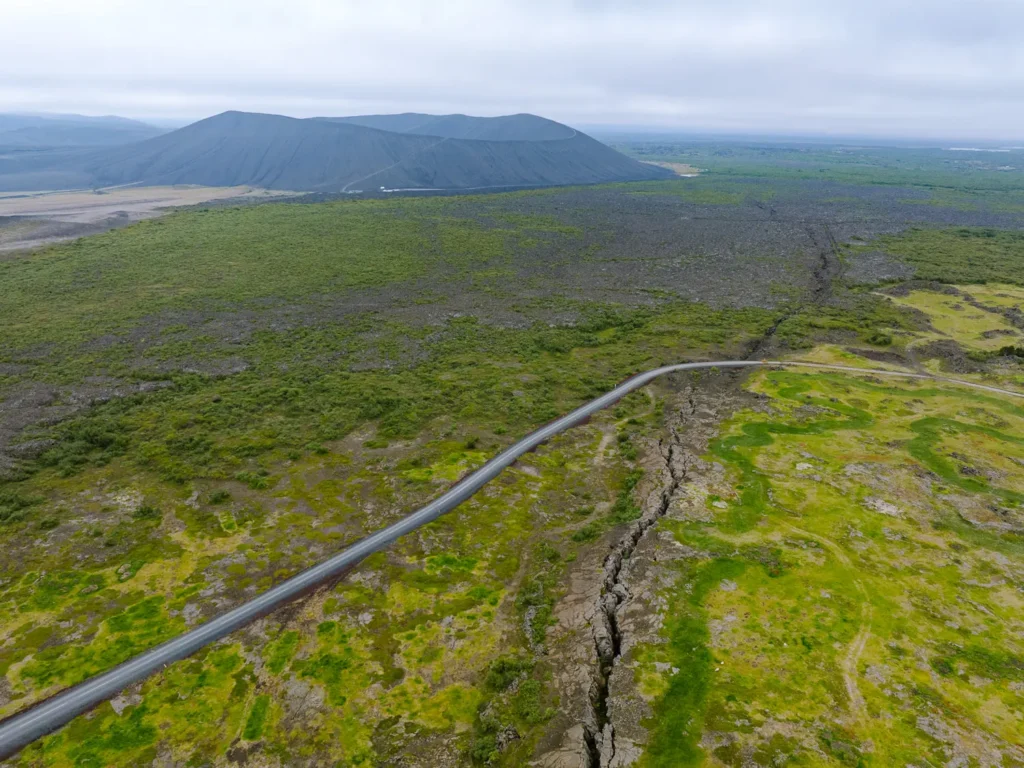
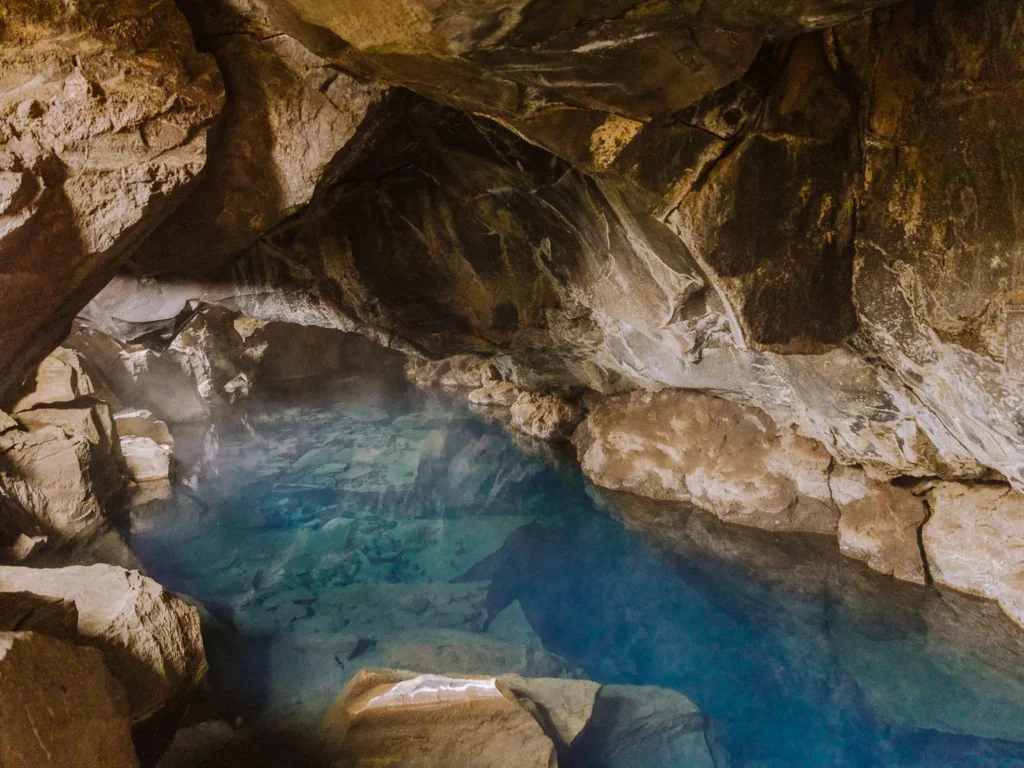
6. HVERIR
The burnt-orange landscape of Hverir – completely bare of all vegetation – is one of the highlights of a visit to the Mývatn area.
Vents in the earth’s crust, called fumaroles, expel volcanic gases and vapours dramatically into the air.
Large mud pots bubble and gurgle, ejecting grey splatters onto the orange-red earth. Boiling rivers cut across the barren landscape.
It’s a fascinating place to visit that feels like you’re walking on the surface of Mars.
Hverir is located just off the Ring Road (Route 1), about 6 km (3.7 miles) east of Lake Mývatn. The geothermal area is a short, easy walk from the parking lot.
It’s open 24 hours and free to enter, although early morning or late evening is better if you want a nice soft light and fewer crowds.
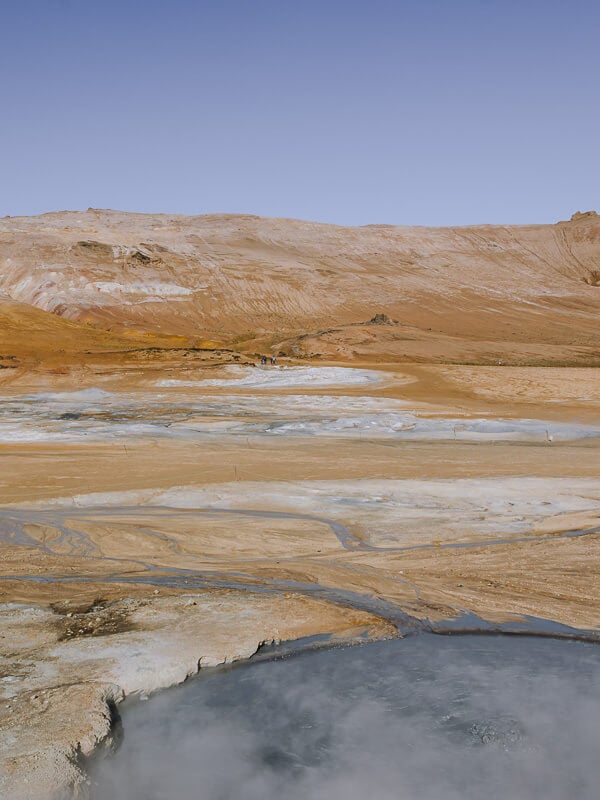


7. KRAFLA
With 29 eruptions under its belt, Krafla is one of Iceland’s most active volcanoes.
The caldera is 10 kilometres wide, but the fissure extends for 90 kilometres. Inside the fissure zone, Viti Crater (not to be confused with the Viti at Askja), with its emerald-green lake, is the showpiece of this incredible natural phenomenon.
Krafla is the force that causes the nearby Grjótagjá Hot Springs to swing across a volatile temperature range.
With liquid rock just 2 kilometres beneath the earth’s surface, it’s a unique source of power that Iceland has been harvesting since 1977.
Viti Crater is accessible via a short 10–15 minute uphill walk from the parking lot.
After walking up to the crater, we had a stroll around the nearby Leirhnjukur Lava Field, which was really interesting.
Located within the extensive caldera, a hiking trail twists through the still-steaming lava field, passing bubbling mud pots, fumaroles and colourful mosses. It was a unique experience walking around a steaming lava field.
There is an easy 1-hour hike on a marked trail. Decent hiking boots are a good idea, and definitely don’t wander off the marked path.
Both Viti and Leirhnjukur are free to enter.


8. MÝVATN NATURE BATHS
The Mývatn Nature Baths is a milky blue lagoon pool, heated by a nearby hot spring.
Although it’s a man-made pool, the lagoon is set overlooking a barren landscape with the facilities nicely blending into the surroundings.
The temperature changes slightly as you move around the pool, but averages a delightfully pleasant 96°F – 104°F (36°C – 40°C).
There are 2 steam baths, a hot tub, a separate pool for kids, a café and a swim up bar where you can order alcoholic and non-alcoholic drinks.
It’s a great balance between the Blue Lagoon, which is expensive and can get very busy, and the completely natural hot springs, like those in the Westfjords, which have no facilities at all.
The baths are open year-round, and we suggest booking in advance as timeslots can fill up.


DAY TRIPS FROM MÝVATN
9. DETTIFOSS
Dettifoss is a powerful waterfall, 77 kilometres (1 hour, 20 minutes) from Mývatn.
Dropping 44 metres into a narrow canyon, it’s the largest waterfall by volume in Iceland and one of the most powerful in Europe.
The falls are fed by the Jökulsá á Fjöllum River, which flows from the Vatnajökull glacier.
The west side of Dettifoss is the easiest access point, with a paved road from the Ring Road and a large car park. There’s an upper and lower viewpoint, and you can expect to get wet at both of them.
It’s a spectacular sight and one of the most impressive waterfalls in Iceland. If you’re based around Lake Mývatn, Dettifoss is a great day trip.

10. HÚSAVÍK
Húsavík is the whale capital of Iceland and one of the best places in the world to see them. Located just 50 minutes from Mývatn, you can easily make it a day trip.
There are 23 species of whales around Húsavík, and a large colony of puffins that are regularly seen here.
In fact, in July, whale spotting is so common it is almost guaranteed.
While we didn’t see any breaching, you can see from the photo below how close we got to them.
Whale watching tours generally run from April to October. There are a few different ways to do it, but we think the Whale Watching Speedboat tour is the best.
After the whale tour, here are a few other things you can do in Húsavík:
- Stroll along the picturesque harbor lined with colorful wooden buildings.
- Visit the Húsavík Whale Museum, home to a 22-metre-long Blue Whale skeleton.
- See the Húsavík Church (Húsavíkurkirkja)
- Visit the GeoSea Geothermal Baths.


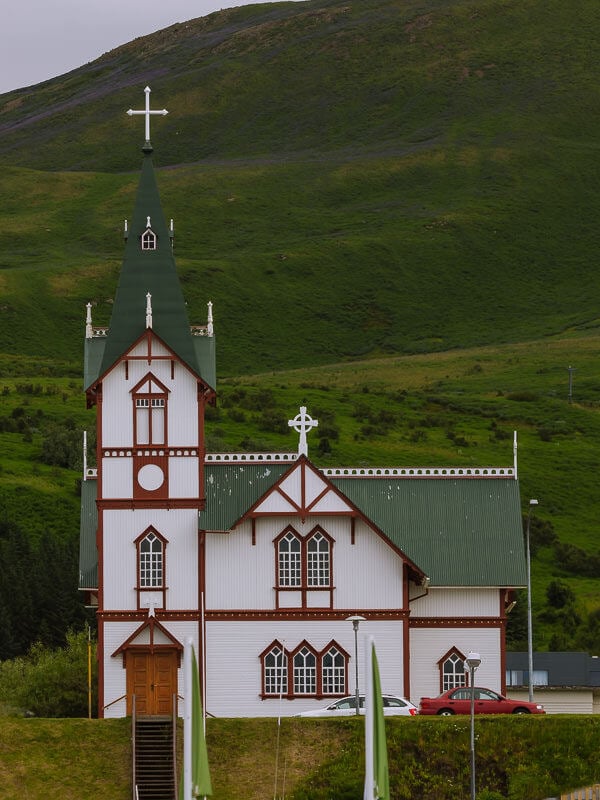

11. ÁSBYRGI
Ásbyrgi is a unique horseshoe-shaped canyon located 40 kilometres east of Húsavík, within the Vatnajökull National Park.
Stretching 3.5 kilometres long and 1.1 kilometres wide, it’s a natural curved canyon that reaches a height of 100 metres.
The thing we really loved about visiting Ásbyrgi is the thick woodland that surrounds the canyon. In an otherwise barren country, it was a bit of a surprise to see various tree species, including birch, spruce, larch and pine.
There are a few hiking paths to explore the area. The most popular is Lake Botnstjörn, a serene body of water located at the base of the canyon.
We also hike to The Island, a 25-metre rock formation that divides Ásbyrgi in half.
DIAMOND CIRCLE // Ásbyrgi is part of the Diamond Circle Route which includes Goðafoss, Námaskarð Geothermal Area, Dettifoss, Ásbyrgi and Husavik.

12. GOÐAFOSS
Goðafoss is a wide horseshoe-shaped waterfall 45 kilometres from Mývatn. Referred to as the Waterfall of the Gods, it’s one of the best waterfalls in Iceland.
The falls are between 9 metres and 17 metres high and curve around low-lying lava fields, forming a horseshoe shape.
There are viewing platforms on both the west and east sides of the falls, and both are worth visiting.
- West Side – Closer to the falls, you’ll get an excellent view of the cascading water.
- East Side – Great for panoramic views and for photographing the entire waterfall from a distance.
You can easily walk between the two viewpoints in about 20 to 30 minutes on a well-maintained path.
Free parking is available on both sides and there are restrooms and basic facilities during high season.

13. ASKJA
Askja is a large volcano situated in the Dyngjufjöll Mountain Range which is part of the Vatnajökull Glacier National Park.
The volcano’s main caldera was formed over 10,000 years ago at the end of the last Ice Age. During an eruption, the roof of the large magma chamber collapsed, causing a massive depression and creating the caldera.
The result was an enormous 45 square kilometre caldera, 8 kilometres in length.
It’s a challenging drive that requires a 4×4, but it’s achievable, and we cover all the information in our detailed guide to Askja.
If you are not interested in the self-drive route, tours also leave from Myvatn.
We’ve been 3 times now, and the big question is – is it worth it?
Askja is interesting, but there is better scenery in Iceland that is easier to get to. Askja is all about the challenge of the drive out there. So if you are thinking of taking the tour, our honest opinion is that there are better ways to spend your time and money in Iceland.
If you’re up for an adventure, a challenging drive and getting off the beaten track, then it might be for you.



14. HLJÓÐAKLETTAR
Hljóðaklettar is a collection of basalt columns located in the Vatnajökull National Park, about 1 hour’s drive from Lake Mývatn.
The columns stretch in multiple directions, creating unique shapes like swirls, spirals, roses, and arches.
The area is known for its acoustic effects, with sounds echoing through the columns, adding a mystical atmosphere to this natural wonder.
There are two hiking trails which start at the parking lot.
- Blue Trail: This 1-kilometre path takes around 30 minutes to complete with easy access to some of the best viewpoints.
- Red Trail: This longer 2-3 hour trail circles the entire area to get the best photographic spots.
Keep an eye out for the fortress-like Kastali, the giant Tröllið and the Kirkjan or church.
From Mývatn, Hljóðaklettar is accessed via the 862, a gravel road which is closed in winter.
STUÐLAGIL // If you are a fan of basalt columns, then you should not miss the remarkable sight of Studlagil Canyon, a few hours’ drive to the east.

PRACTICAL INFORMATION
WHERE TO STAY IN MÝVATN
Most hotels in Myvatn are spread along the lakeshore, where you’ll also find a few other essentials such as a small supermarket, fuel stations and some restaurants.
For more recommendations, read our guide on where to stay in Iceland.
- Fosshotel Mýatn ($$$) – A modern, comfortable chain hotel with a good selection of facilities, including free Wi-Fi, private bathrooms and 24-hour reception.
- Hótel Laxá ($$$) – Quality, modern accommodation with all the amenities you need for a comfortable stay.
- Skútustadir Guesthouse ($) – Cosy guesthouse with shared kitchen and lounge area, free Wi-Fi and laundry facilities. Private or shared bathrooms are available.
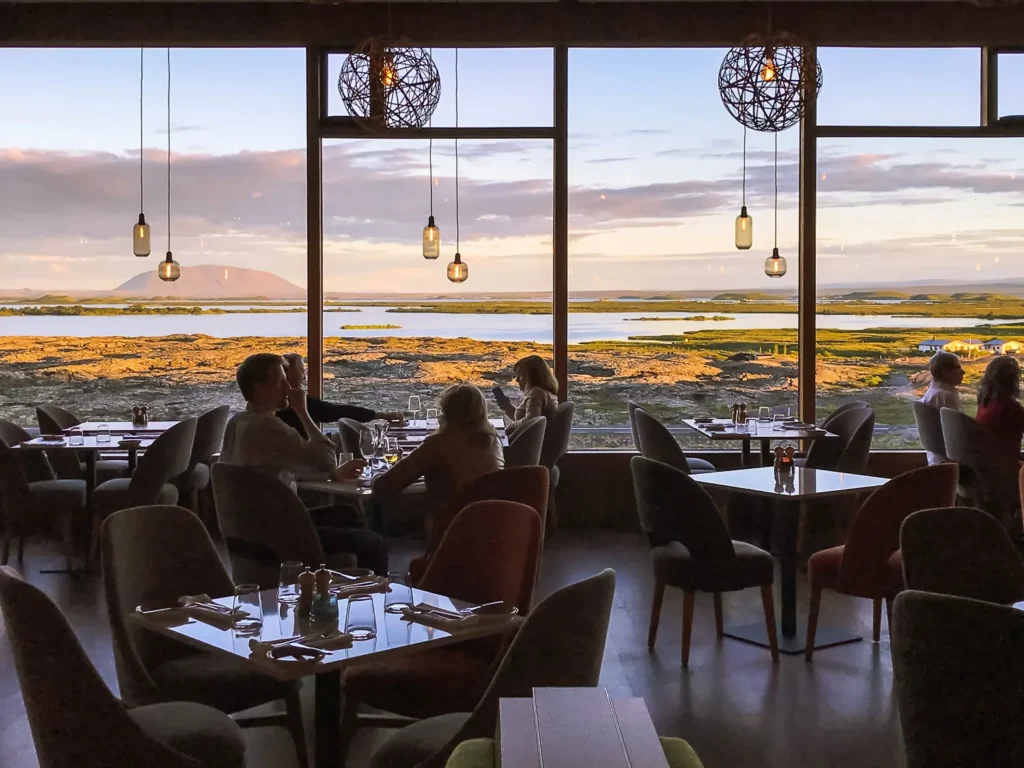
WHEN TO GO?
The best time to go to Mŷvatn is in Summer (June to August). The weather is the most promising, and with almost 24 hours of daylight, you’ll have time to fit everything in.
The shoulder seasons, May and September, are also a great time to visit with fewer crowds. Mývatn generally sees fewer visitors than other parts of Iceland.
HOW LONG DO YOU NEED?
We spent 2 nights in Mývatn, which gave us time to see the area’s most important sights, including Dimmuborgir, Hverfjall Crater, Hverir, Grjótagjá Cave, and the Mývatn Nature Baths.
If you are doing day trips from Mývatn, you will probably need longer. The best day trips are Dettifoss and Ásbyrgi on one day, and Húsavík on another.
We picked up a few more sights on the morning of our 3rd day on the way to Blönðuós, where we stayed the night after Mŷvatn. Read our Ring Road itinerary for all the details.
HOW TO GET THERE?
The only way we would recommend seeing Mývatn is in your own car. It’s easy to get to via the Ring Road and it will give you a lot more flexibilty to see the things you want to see.
For more information, read Driving in Iceland and our Ring Road itinerary, which puts everything together for you.
TIPS FOR VISITING MÝVATN
Midge Protection: We can’t stress this enough: the midges around Lake Mývatn can be absolutely overwhelming. Bring strong insect repellent, and seriously consider packing a head net or scarf.
Fill Up on Fuel: Petrol stations are limited around Mývatn. Fill up whenever you see one, especially if you’re planning day trips to remote areas like Dettifoss or Askja. The main petrol station is N1 in Reykjahlíð, which is open daily and has a small shop.
Grocery Shopping: There’s a small supermarket near Reykjahlíð, but selection is limited and prices are higher than in larger towns.
Road Conditions: Check road.is for up-to-date road conditions and closures, especially if visiting in winter or planning to drive on F-roads (for example, to Askja).
Weather: Icelandic weather is notoriously unpredictable. Always dress in layers and bring waterproofs, even in summer. Good hiking boots are essential if you hike trails like Hverfjall Crater.
ATMs & Money: There’s an ATM at the N1 petrol station in Reykjahlíð. Most places accept credit and debit cards, but it’s wise to carry some cash for emergencies or small purchases.
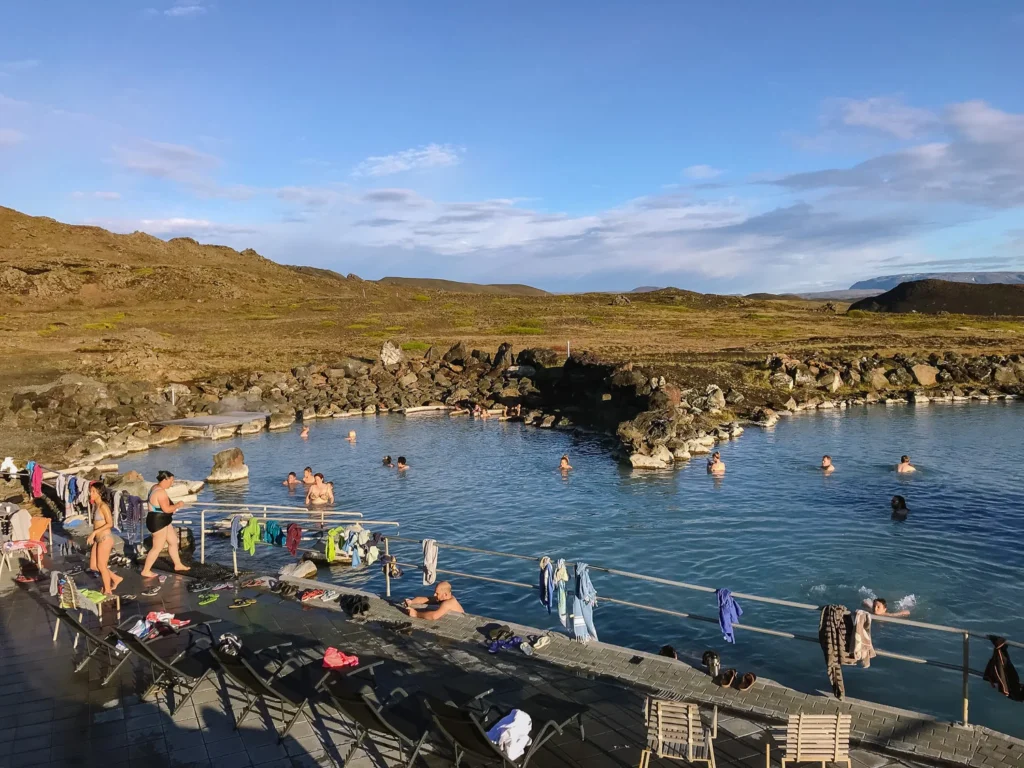
MORE ICELAND RING ROAD GUIDES
- Check out our 10-day Iceland Ring Road itinerary.
- Make sure you don’t miss our favourite places to visit in Iceland.
- Looking for accommodation on the Ring Road? Here’s where to stay in Iceland.
- Don’t miss a thermal soak with our guide to the best hot springs in Iceland.
- Just off the Ring Road is Iceland’s newest volcano – Fagradalsfjall.
- The best way to spend a day seeing Iceland’s iconic Golden Circle.
- Tips for getting good pictures of the puffins at Dyrhólaey Peninsula.
- When driving the Ring Road don’t miss Vestrahorn – Bat Mountain.
- How to spend a few days exploring Myvatn.
- A complete list of our favourite waterfalls in Iceland.

READER-SUPPORTED
When you buy through links on our site, we may earn a small affiliate commission at no extra cost to you.
Thanks for your support.
Paul & Mark.

